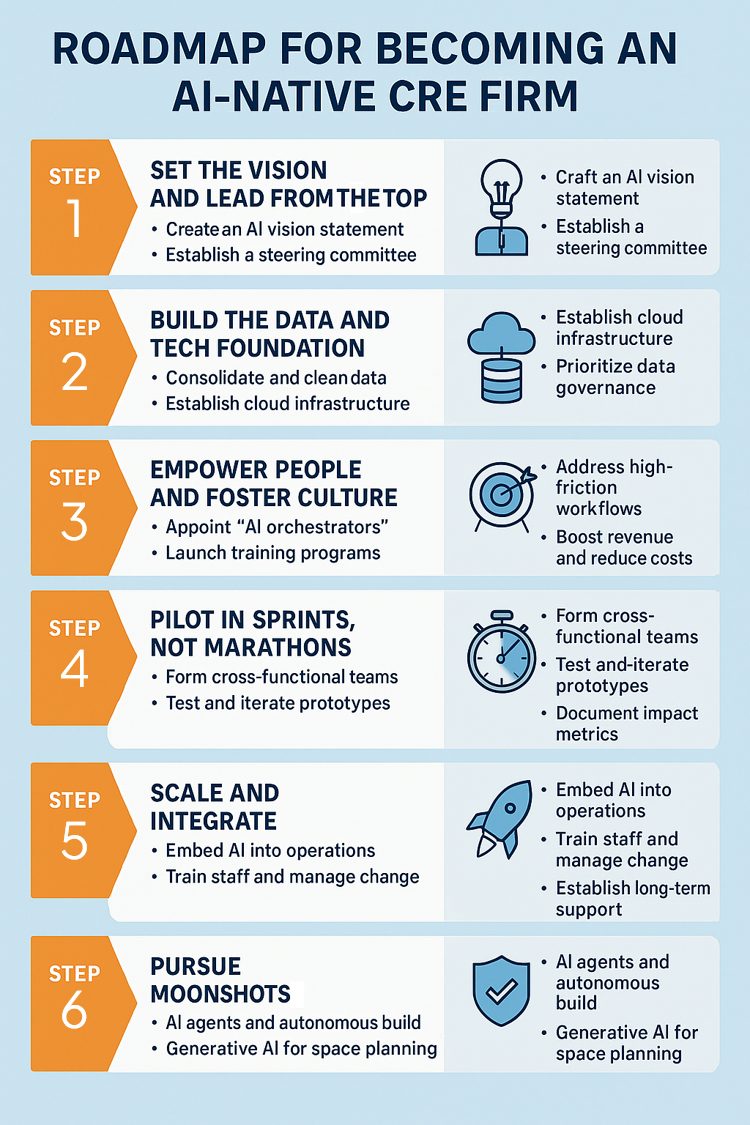Commercial real estate (CRE) is entering a new era—one where AI-native firms will dramatically outpace their competitors in productivity, insights, and agility. But what does it actually mean to be “AI-native”? And more importantly, how can your firm get there?
This post lays out a comprehensive, step-by-step strategy based on our Comprehensive Strategic Plan for Becoming an AI-Native Commercial Real Estate Company. It’s not about chasing hype. It’s about building a foundation for exponential performance.
Step 1: Set the Vision and Lead from the Top
Becoming AI-native starts with a bold vision—and executive commitment. The leadership team must define how AI will be woven into the firm’s DNA: augmenting human work, accelerating decisions, and multiplying impact. This begins with:
- Crafting an AI vision statement that aligns with business priorities (e.g. faster deal cycles, superior client service).
- Establishing a steering committee, ideally led by a CEO or CTO.
- Committing early to ethical AI principles (transparency, fairness, data privacy).
Leadership buy-in isn’t optional—it’s the spark that powers everything else.
Step 2: Build the Data and Tech Foundation
AI is only as good as the data and infrastructure it runs on. That means:
- Consolidating and cleansing operational, financial, and property-level data.
- Establishing cloud-based infrastructure with modern data pipelines and model support.
- Considering internal platforms (like JLL’s Falcon) to support scalable, secure AI use.
- Prioritizing data governance, security, and compliance.
Many CRE firms begin their journey here, but without executive vision and culture alignment, data projects can stall.
Step 3: Empower People and Foster Culture
Tech doesn’t transform companies—people do. To drive adoption and sustain innovation:
- Appoint “AI orchestrators” within departments to lead initiatives.
- Launch training programs to build AI literacy.
- Hire or partner to fill data science and AI engineering gaps.
- Create internal forums for ideation (e.g., hackathons, pilot contests).
This cultural groundwork sets the stage for transformation from within.
Step 4: Identify Use Cases That Matter
Not all AI projects are equal. Prioritize initiatives that:
- Address high-friction workflows (e.g. lease abstraction, deal underwriting).
- Boost revenue (e.g. market prediction models, personalized investor outreach).
- Reduce costs (e.g. predictive maintenance, invoice automation).
Start small with high-ROI “quick wins”—then build momentum. For ideas, see How CRE Agents Uses AI to Automate Workflows in Commercial Real Estate.
Step 5: Pilot in Sprints, Not Marathons
Each use case should start as a pilot:
- Form small, cross-functional teams to build MVPs.
- Test prototypes in real workflows, gather feedback, and iterate.
- Document impact metrics and user experiences.
Pilots allow you to learn fast, improve faster, and de-risk innovation.
Step 6: Scale and Integrate
Proven pilots should be scaled with purpose:
- Embed AI into daily operations (CRM, leasing, asset management).
- Train staff broadly and manage change with transparency.
- Establish long-term support for AI systems (IT, data, and process owners).
This is when transformation becomes institutionalized.
Step 7: Pursue Moonshots
Once the basics are humming, look to 10x and 100x ideas:
- AI agents that underwrite deals.
- Autonomous buildings that run themselves.
- Generative AI for space planning and scenario modeling.
- AI-enabled investor and tenant personalization at scale.
For inspiration, check out Behind the Scenes: Digital Coworker Team of AI Agents for Commercial Real Estate.
Step 8: Govern Wisely, Scale Confidently
Trust is earned through strong governance:
- Set up an AI ethics committee and fairness checks.
- Ensure secure handling of sensitive data.
- Monitor compliance with evolving regulations.
Well-governed AI inspires confidence—and unlocks faster scaling.
Step 9: Monitor, Refine, Innovate
Becoming AI-native is a journey:
- Track KPIs like time saved, ROI, and user satisfaction.
- Keep collecting feedback and recalibrating strategy.
- Stay close to emerging tech, new partnerships, and evolving market needs.
The most successful firms will turn AI-native into a flywheel of continuous innovation.
Conclusion
The AI-native future of CRE is already here for some firms. With a clear roadmap, yours can be one of them. This isn’t about automation for automation’s sake. It’s about empowering your people, delighting your clients, and multiplying your impact.
Now is the time to act.

